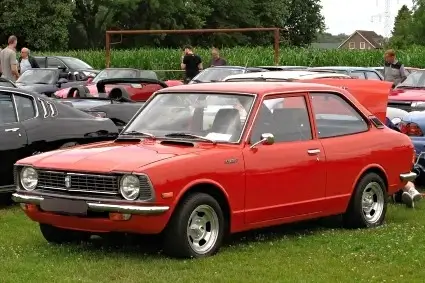Toyota Tyres
Classic Toyota Tyres
On the following pages, Longstone Classic Tyres give classic tyre fitment recommendations for Toyota Cars.
If your car is not listed, don't panic! Please give us a call on:
01302 711 123
or
Email: sales@longstonetyres.co.uk
Vintage Toyota Tyres
In these pages we make recommendations for tyre fitments for your classic Toyota. The recommendations we give are what we believe will make your car perform best for your chosen price range. We provide tyres for many brilliant classic Toyota models, from the humble Camry to the exquisite 2000GT. If your classic Toyota is not listed on our website, please get in contact and we will find you the perfect tyre for your Toyota.
Toyota History

Toyota began in 1933 when the firm was a section of 'Toyoda Automatic Loom Works' dedicated to the manufacturing of automobiles under the guidance of the founder's son, Kiichiro Toyoda. In 1929, Kiichiro Toyoda travelled to Europe and the United States to observe automotive manufacture, and in 1930, he began exploring petrol-powered motors. The Japanese government urged Toyoda Automatic Loom Works to boost automotive manufacture since the country required domestic vehicle production owing to the conflict with China. On September 1, 1933, Kiichiro Toyoda took advantage of this chance to create the Automotive Production Division and began planning to produce prototype vehicles.
The division created its first Type A Engine in 1934, which was utilised in the Model A1 passenger vehicle in May 1935. In 1936, the manufacturing of the Model AA passenger automobile began. Toyota Motor Co. was founded in 1937 as a separate and independent corporation. Despite the fact that the founding family's name was originally written in Kanji "豊田" (translated as "Toyoda"), the business name was altered to a similar word in katakana - (represented as "Toyota") since the latter contains 8 strokes, which is considered lucky in East Asian culture.
During the 1930s, as the Japanese economy modernised and expanded, both Ford and GM established plants in Japan where automobiles were shipped from America in knockdown kits and constructed locally. The Ford Yokohama plant opened in March 1925, while GM opened a factory in Osaka in April 1927. By 1929, Ford and General Motors controlled the majority of the Japanese automotive market, manufacturing 28,000 automobiles in 1929. During the creation of the Toyota AA, the corporation acquired locally built GM and Ford items, reverse engineered them, and employed engineers who had previously worked in Japanese Ford and GM plants to build Toyota products.

In World War 2, the firm was devoted to producing trucks for the Imperial Japanese Army. Due to the acute scarcity of resources in Japan, military vehicles were designed to be as basic as feasibly possible. The vehicles, for example, featured only one headlight in the centre of the bonnet. The war ended just before an Allied bombing raid on the Toyota plants in Aichi.
Japan faced severe economic difficulties following World War II. The type SA was the first commercial passenger automobile produced in 1947. By the end of 1949, the firm was on the verge of bankruptcy, but it finally acquired credit from a group of banks that demanded an autonomous sales operation and the removal of "excess manpower".
In June 1950, the firm had only built 300 vehicles and was on the verge of going out of business. When management proposed layoffs and salary cuts, the union went on a two-month strike in retaliation. The strike was ended by a deal that included not just layoffs and wage cuts, but also the resignation of the company's president, Kiichiro Toyoda. Taizo Ishida, the chief executive of the loom branch of the company, replaced Toyoda. The firm was resurrected after the US military ordered over 5,000 cars during the opening of the Korean War. The establishment of the Motomachi Plant in 1959, for example, provided Toyota with a major advantage against Nissan during the 1960s.

Toyota Motor Sales Co. was created in 1950 as a distinct sales firm. The Toyopet dealer network was founded in April 1956. Toyota's American and Brazilian businesses, Toyota Motor Sales Inc. and Toyota do Brasil S.A., were also founded in 1957, with the Crown being the first Japanese automobile to be shipped to the United States.
Toyota began to expand in the 1960s with the establishment of a new research and development centre, the establishment of a presence in Thailand, the production of the ten millionth model, the awarding of the Deming Prize, and the formation of alliances with Hino Motors and Daihatsu. The first Toyota constructed outside of Japan occurred in Melbourne, Australia, in April 1963. Toyota's largest export market from 1963 to 1965 was Australia. Toyota had developed a global footprint by the end of the decade when it exported its one-millionth vehicle. In May 1953, the first Japanese automobiles to arrive on the American continents were five Land Cruisers in El Salvador. The first Toyotas sent to Canada were 115 Crowns in February 1965.
Two Toyopet Tiaras were delivered to Finland for examination in June 1962, but no sales followed, despite the importer introducing the cars to the press in October of the same year. Erla Auto Import A/S of Denmark was the first European importer, bringing in 400 Crowns after a May 1963 arrangement to become the distributor for Denmark, Norway, and Sweden. Following the Netherlands in May 1964, and after establishing footholds in nations with little or no native automotive manufacture, more countries followed in 1966. Toyota's first European CKD manufacturer, Salvador Caetano I.M.V.T. of Portugal, was formed in 1968.



